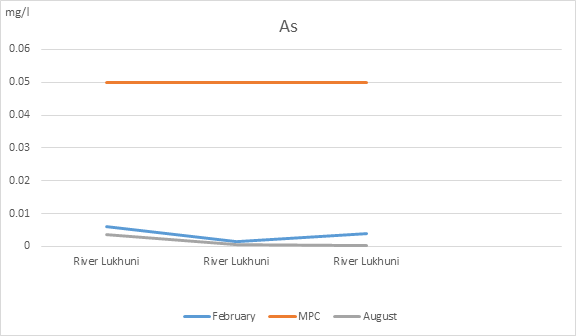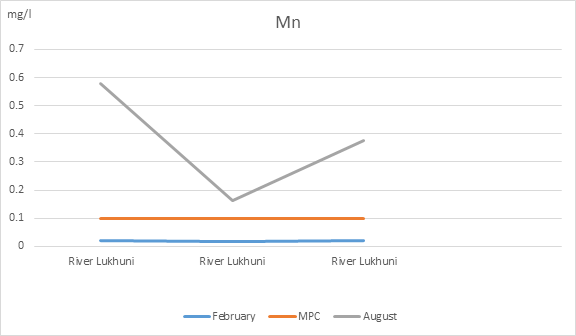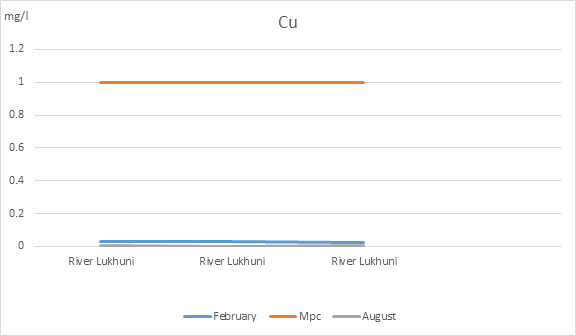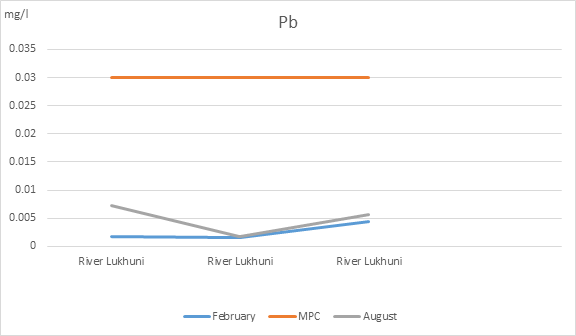J. Geo. Chem. Soc., 2022, Vol. 2, Issue: 1, pp. 0 - 0
The current state of arsenic deposit in the Lukhuni Gorge in Accordance with the 2021 Data
1 LEPL National Environmental Agency of the Ministry of Environment Protection and AgricultureTbilisi, Georgia
2Georgian Technical University, Tbilisi, Georgia
Abstract. The study deals with chemical pollution of the environment, in particular arsenic contamination of soil and water, which is a highly pressing problem for both Georgia and the world. The solution is to develop innovative remedial technology based on the ability of plants and microorganisms to absorb a wide range of chemical pollutants from the environment.
Toxicity of arsenic and its compounds is well known. In the seventies of the last century, their carcinogenic properties were established. Still, arsenic compounds are widely used in technology, agriculture, medicine, etc., Arsenic is a natural component of the earth’s crust and is spread in any environment, air, water and soil. In a number of countries arsenic is naturally of high contents in the ground waters.
Keywords: Sampling, Arsenic, Environment Water, Soil
Introduction
This element is present in nature in both organic and inorganic forms, and the latter is very toxic. Long-term exposure to arsenic from consumed food can cause cancer and skin lesions [1,2]. Hence, control of arsenic content in natural waters, soils and food products and other objects and studying the regularity of redistributions (pathways and mobility) and behaviour is one of the most important and topical issues in the world.
Arsenic is included in the list of 10 toxic elements (Hg, Pb, Cd, As, Ni, etc.) that create important problems for human health (WHO) [3].
Arsenic and arsenic compounds belong to the confirmed carcinogens, the Type I Hazard (IARC) for humans [4].
Beside the fact that skin and the respiratory tract can be the paths of the arsenic penetration into organism still mostly arsenic can occurs in human body from the food and drinking water. Organic arsenic species are most often met in seafood and in units of terrestrial products. This terrestrial product is basically 3-5 valence arsenic forms. Therefore, arsenic enters the food chain mainly from contaminated soil and water [5,6].
The maximum permissible concentrations of arsenic in the surface waters of 0,05 mg/l; In drinking water - 0,01 mg/l; In the soil - 2 mg/kg [7-9].
Arsenic is found in all kinds of soil. The quality of its oxidation is -3, 0, +3, +5; the most wide-spread are arsenic - As2O3 and arsenic -As2O5. In terms of toxicity, arsenic chloride and salts such as lead arsenate, copper acetarsenate and Arsin (AsH3) are important.
Arsenopyrite (FeAsS) is a pollution source for fresh waters. Pollution is mainly caused by different enterprises and it is accumulated at the adjoining territory (pollutants are formed during arsenic ores or as a result of arsenic ores depletion in the nature) in the form of arsenic anhydride (As2O3) and other compounds, that causes their accumulation in water, soil and plants.
From the eco-chemical point of view, according to contact duration with soil and water, and physical-chemical conditions, arsenic oxide (As2O3) and sulfides can be conversed according to basic chemical reactions peculiar for them. Arsenic oxide dissolution in the water proceeds very slowly, but it becomes more intense in the presence of hydrogen and hydroxyl ions.
As2O3 + 3H2O → 2As(OH)3
As2O3 + 3H2O → 2H3AsO3
A formed arsenic acid is dissociated in the water as an acid and a base; acidic properties are prevalent: As(OH)3 3H++ AsO3-3. Proceeding from amphoteric nature of arsenic, As2O3 acts both on acid and alkali and salts are formed [10].
In contradistinction from oxide forms, arsenic sulfides due to their low solubility are not hazardous for the environment, though sulfide ores and enriched products (beneficiaries) placed in the open air, under the influence of exogenic processes experience hypergene replacement of ore-forming minerals – in oxidizing environment arsenic of sulfide ores and carbon deposits moves to instable sulfates, while in weakly acid solutions it experiences hydrolysis and is taken out of the environment. As a result of this and other processes that are known under the name of self-purification, water more or less retakes the initial chemical and bacteriological composition. Suspended particles (floating deposits) and bottom sediments are one of the sources of substances dissolved in the surface waters. Suspended particles enriched in heavy metals may cause surface waters pollution, in particular, if water acidity increases, highly mobile sorbed form of metals will move to aqueous phase [11] and transforms into mobile form.
Such types of enterprises represent a significant risk factor for ecosystems in the region.
Cases of contamination of arsenic of food products are highlighted in many labor [12-14]. The maximum permissible concentration of arsenic in vegetable food products is 0,2-1 mg / kg of dry mass [15].
According to the Basel Convention, arsenic belongs to the category of controlled waste [16].
All the previously mentioned conditions that arsenic is in a standardized list of high-risk substances are listed in order of The Minister of Labor, Health and Social Affairs of Georgia on Approval of the norms of the Quality of Environmental Conditions, August 29, Tbilisi, 2001 [17].
There are many natural or anthropogenic sources in Georgia that predetermine environment pollution with arsenic compounds: arsenic ores extraction, processing and production of arsenic-containing preparations took place for decades (in Racha and Lower Svaneti). As of today, both deposits are deactivated and arsenic is not produced. Large amount of toxic waste (approx. more than 130 tons containing 4-9% white arsenic) remained as a result of arsenic production kept from the Soviet period at the territory of mining and chemical combines in Uravi and Tsana villages. These residuals were not safely disposed and created high risk of ecological disaster in the rivers, ground waters and soils [18-120].
Thus, the main mechanism of arsenic waste dissemination is connected to atmospheric sediments and toxic waste and toxic waste by flooded rivers. Naturally these processes are in the rivers: Lukhuni, Koruladashi, Tskenistskali and Rioni gorges, where large settlements of Racha-Lechkhumi and Kvemo Svaneti are located. The danger is contamination of agricultural lands and pastures, resulting in disastrous consequence of food products and threats to environment and human health. In addition, the river Rioni is the main source of Kutaisi drinking water in western Georgia. Also the river Tskhenistskali is used as a drinking water for irrigated regions and irrigation of agricultural lands. Since rivers Lukhuni and Tskhenistskali represent the tributary of the Rioni, therefore their hydro-chemical and microbiological study is relevant.
At the same time, one of the factors in the improvement of the severe social economic conditions of the population of mountainous regions of Georgia is the revival of tourism in mountainous regions. Especially when it comes to the most beautiful regions of Georgia such as Racha-Lechkhumi and Kvemo Svaneti. The basic and necessary condition for determining the risks for the local population and the health of people who have arrived and the wastes of the arsenic should be avoided, and environmental preventive measures should be taken [10].
It should be mentioned that in 2014-2016 the Ministry of Environment and Natural Resources Protection of Georgia and the Ministry of Economic Affairs of the Netherlands were involved in the project "Management of Mining Arsenic Wastes in Georgia". Aim was to define the arsenic content in the ecosystems in the region (soil, water, floated deposits, bottom sediments) and food product, identifying the risk and determination of the needs and volumes of specific arrangements for the specific region and of appropriate preventive measures were conducted.
Research zone and methods
It is known that Racha is one of the important agricultural regions of Georgia. Therefore, special attention should be paid to the ecological status of this region. In this sense, we conducted research in the vicinity of the Lukhuni, Arsenic Deposit and Processing Enterprise in Ambrolauri Municipality. It is very important to have a hydrochemical characterization of surface water adjacent to the former enterprise. Field work was carried out in February and August 2021: Analyzes were carried out using modern methods and equipment that meet and comply with European standards, namely:
1. Plasma-Emission Spectometer ICP-Oes-Based on the standards of the Axial Induction Plasma Spectrometer ISO 11885: 2007;
Discussion of the Results
On the figures 1,2,3 and 4 are given the variability of heavy metals, manganese, arsenic and lead concentration in 2021year.
According to the results of the analysis, according to February 2021, no metals in the Lukhuni River sample exceeded the permissible concentration.
As for the samples taken in August, only high manganese content was recorded in all three samples from the Lukhuni River.

Figure 1. Dynamics of arsenic content in the II and VIII months of 2021.
 MPC - 0,05mg/l
MPC - 0,05mg/l

Figure 2. Manganese content dynamics in the II and VIII months of 2021.
 MPC - 0,1 mg/l
MPC - 0,1 mg/l

Figure 3. The dynamics of copper content in the II and VIII months of 2021.
 Mpc - 1 Mg/L
Mpc - 1 Mg/L

Figure 4. Lead Dynamics in the II and VIII of 202.  MPC - 0.03 Mg/L
MPC - 0.03 Mg/L
Table 1. The content of heavy metals in the shallow waters, February, 2021
|
N |
Ingredients |
River Lukhuni |
River Lukhuni upper point |
River Lukhuni lower point |
MPC* |
|
1 |
As, mg/l |
0.0061 |
0.0015 |
0.0038 |
0,05 |
|
3 |
Cu, mg/l |
0.0317 |
0.0289 |
0.0248 |
1,0 |
|
5 |
Mn, mg/l |
0.0218 |
0.0198 |
0.0204 |
0,1 |
|
6 |
Pb mg/l |
0.0017 |
0.0015 |
0.0044 |
0,03 |
|
7 |
Zn mg/l |
0.0143 |
0.0116 |
0.0104 |
1,0 |
MPC* - Maximum Permissible concentration According to the Superficial Water Technical Regulations (Resolution of the Government of Georgia No. 425, December 31, 2013, Tbilisi), Tbilisi)
Table 2. The content of heavy metals in the shallow waters, August, 2021
|
# |
Ingredients |
River Lukhuni |
River Lukhuni upper point |
River Lukhuni lower point |
MPC* |
|
1 |
As, mg/l |
0,0037 |
0.0004 |
0,0003 |
0,05 |
|
3 |
Cu, mg/l |
0,0066 |
0.0011 |
0,0053 |
1,0 |
|
5 |
Mn, mg/l |
0,5772 |
0.1635 |
0,3776 |
0,1 |
|
6 |
Pb mg/l |
0,0072 |
0.0018 |
0,0056 |
0,03 |
|
7 |
Zn mg/l |
0,0135 |
0.0030 |
0,0075 |
1,0 |
The Lukhuni (Lukhumi) arsenic deposit is located in the Ambrolauri municipality, in the valley of Madnisghele (left tributary of the Lukhuni River). The ore extraction in the field began in 1937. Since 1991, production has stopped functioning. Currently the Uravian plant, all auxiliary buildings and infrastructure are destroyed. The burial of the Urav plant production waste, located 14 km from the plant, is canned. Because the tomb has been damaged over time, so there is a danger of toxic waste to the Lukhun River.
However, it should be noted that the existence of toxic waste in the river Lukhuni in 2021 has not yet been confirmed. It should also be noted that in all three samples of the Lukhuni River in August, high content of manganese was observed: Lukhuni, River upper point and Lukhun River lower point. We believe that the existence of a higher amount of manganese concentration is due to the presence manganese minerals in the soil.
Conclusions and Recommendations
Based on the results obtained by hydrochemical analysis of natural waters studied, the following conclusion may be expressed:
The state of the Lukhuni River is satisfactory in 2021year and to maintain this condition, more attention should be given to the remains of the aforementioned deposit to prevent the future contamination of the Lukhuni River with toxic elements.
Approach to healthy water is definitely included into basic human needs. water becomes a strategic raw material influencing the development of particular regions and whole geographic areas. There are many localities all over the world that suffer from not only lack of water but also from its contamination by harmful substances. The contamination by arsenic has become more and more important, because of its strong carcinogenic and teratogenic effects. Long-term arsenic receiving, even at lower concentrations, is harmful to health and even mortal. Therefore, the World Health Organization decreased maximal allowed arsenic concentration in drinking water to 10 μg/l in 1993.
More studies point the fact that arsenic removal from contaminated water is a proper effective way to health risk minimization. In order to secure requested surface and drinking water quality there can be applied different technological processes. Technologies available at present include chemical precipitation (coagulation), adsorption, ion exchange, membrane filtration, phytoremediation and electro-coagulation. It is very difficult to propose the best course, because each technology has disadvantages and advantages, especially as far as efficiency and cost which play a decisive role in design of technology for water improvement. The raw water quality must be always taken into account. It is also necessary to evaluate by-products of technological course which can be another resource of environmental pollution by arsenic. Simplicity and flexibility, reliable operation and easy maintenance of technological line for water improvement are important factors that are necessary in designing of sustainable technologies. The general trend in the field of water improvement is to use as little chemicals and energy as possible in order to decrease cost.
Though we had not found water contamination with arsenic, below is discussed some treatment possibilities. If water has been contaminated by toxic substances, water treatment is essential. Inorganic arsenic is found in groundwater worldwide, which is present as anionic arsenate or uncharged arsenite depending on the redox potential. Studies have shown very high concentrations regionally which can lead to chronic poisoning – which is harmful to health. To ward off this danger and eliminate arsenic in water. Granular ferric hydroxide is capable of selectively removing toxic substances from water, thereby preserving valuable trace elements and minerals.
Also some patented solutions for treating water and eliminating arsenic is in use worldwide. a patented media with an adsorption capacity up to five times higher than that of competing products. In addition, an arsenic removal system allows long lifetimes and application in line with demand. Completely free of arsenic-contaminated sludge or waste water, without chemical storage or dosing, easy and maintenance-free to implement in plant technology. Product can be used without any problems as an arsenic removal filter in adsorption filters, such as standard filter containers or classic cartridge systems.
It should be noted that almost in all of the treatment technologies, one does need to be aware of the waste products that are generated. In the conventional (and direct filtration) technology, waste sludge is generated that could potentially be very hazardous. The waste sludge in this case would have to be disposed of (or treated) properly. All of the above technologies generate some sort of waste product.
References
- B. Gagoshidze, M.O. Antelava, A.G. Zedginidze. “Effect of arsenic-contaminated environment on the genetic apparatus of children and adolescents”. Georgian Medical News, Vol. 117, No. 12, pp. 59-62, 2004 (in russian).
- B. Gagoshidze, M.O. Antelava, A.G. Zedginidze, N. Sh. Mandgavidze. “Influence of the environmental situation on the incidence of acute respiratory diseases in children”. Georgian Medical News, Vol. 118, No. 1, pp. 49-52, 2005 (in Russian).
- G. Skalnaya, A.V. Skalny, V.A. Demidov “Dependence of the increased oncologic morbidity rate from the excessive contents of arsenic and other toxic chemical elements in environment”. Trace elements in medicine, Vol. 2, No. 1, pp. 32-35. 2001.
- Arsenic, metals, fibres, and dusts. IARC monographs, Vol. 100 C, Lyon, France, 2012.
- Laperashvili. “Food safety”. Georgian strategic researches and development center bulletin, No. 111, 2008.
- European Food Safety Authority, European Food Safety Authority (EFSA), Parma, Italy. “Scientific report Of EFSA: Dietary exposure to inorganic arsenic in the European population”. EFSA Journal, 12, No. 3, pp. 3597. 2014
- On the approval of the technical regulations of protection against the protection of the surface water of Georgia. Government of Georgia, Resolution No. 425, December 31, 2013, Tbilisi.
- On the approval of drinking water technical regulations. Government of Georgia Resolution No. 58. January 15, 2014, Tbilisi
- Methodological instructions to evaluate the degree of hazard of contamination of the soils with chemicals -Order N 38/N February 24, 2003, Tbilisi.
- Bagrationi, L. Gvertsiteli, V. Gvakharia, A. Chirakadze, T. Sharashidze."Ecological description of the Arsenic waste storage and warehousing facilities”. Proceedings of the Georgian Academy of Sciences, No. 4, pp. 92-114, 2014.
- Supatashvili. “Environmental Chemistry (Ecochemistry)”. Tbilisi: Tbilisi University, pp.188, 2009.
- Commission Recommendation (Eu) 2015/1381. Recommendations on the monitoring of arsenic in food. Official Journal of the European Union. 10 August 2015
- EFSA Panel on Contaminants in the Food Chain (CONTAM). “Scientific Opinion on Arsenic in Food”. EFSA Journal, Vol. 7, No. 10, 2009
- Dugashvili. "Arsenic Distribution in Georgian Vegetable Foods", Tbilisi, Autoreperat, 2006.
- The Basel Convention on the ‘’Control of Transboundary Movements of Hazardous Wastes and their Disposal’’. Basel (Switzerland), 22 March, 1989
- Approval of the norms of the qualitative state of the environment of the Minister of Labor, Health and Social Affairs of Georgia, on 29 August / Tbilisi, 2001. Approval of sanitary rules and norms for quality and safety of food raw material and foodstuffs. Order # 301 / N, 16 August 2001 of the Minister of Labor, Health and Social Affairs of Georgia.
- On the approval of the norms of the quality condition of the environment. Order No 297/N of Minister of Labor, Health and Social Affairs of Georgia on Environmental Quality Requirements, Tbilisi, 2001
- Alexidze, R. Lolishvili. “Basic Aspects of Georgia›s Environmental Pollution”. International Scientific Conference "Modern Technologies of Eco-friendly Products for Sustainable Development of Agriculture", Tbilisi, pp. 33-45, 2016.
- Gigauri, N. Bibiashvili, L. Baghaturia. “Monitoring and Remediation of Wastes of Racha-Svaneti in Georgian Regions” . Chemical Materials of Georgia, Vol..15, No. 1, pp.119-122, 2015
- Shavliashvili, E. Bakradze, M. Arabidze, G. Kuchava. “Arsenic pollution study of the rivers and soils in some of the regions of Georgia”. International Journal of Current Research, Vol. 9, No. 2, pp. 47002-47008, February, 2017.
- Khubutia. “Distribution of heavy metals in the soils of Bolnisi district”. A. Janelidze Geoloical Institute, Proceedings, Vol. 119, pp. 861-864, 2004.
- Gvakharia, G. Samarguliani, N. “Machitadze Influence of Anthropogenic Factors on the Distribution of Heavy Metals in Waters and Soils of Bolnisi Region”. Bull. of Georgian Academy of Sciences, Vol. 156, No. 1, pp. 81-85, 1997.
- Bakradze. “Geo-Ecological Monitoring of River Mashavera and River Polladauri watersheds” PhD Thesis, Georgian Technical University, 203 p., 2012.
- G. Priazhinskaia, D. M. Iaroshevskii, L. K. Levit-Gurevich. “Computer modeling in water resources management”, Moscow: FIZMAIT, 2002.
- Tsegaye , P. R. Koya. “Modeling and Numerical Simulation of River Pollution Using Diffusion – Reaction Equation”. American Journal of Applied Mathematics. Vol, 3, No. 6, pp. 335-340, 2015
- Pimpunchat, W.L. Sweatman, G. C. Wake, W. Triampo, A. Parshotam. “Numerical Model for Pollution in a River and its remediation by Aeration”. Applied Mathematics Letters. Vol. 22, No.. 3, pp. 304-308, 2009
- Surmava, L. Intskirveli, N. Buachidze. “Numerical Simulation of Distribution of contaminants discharged to Kura River”. Bulletin of the Georgian National Academy of Sciences. Vol. 9, No. 1, pp. 78-83, 2015
Recieved: 06-12-2022 | Web published: 30-11--0001 | Views 2481


